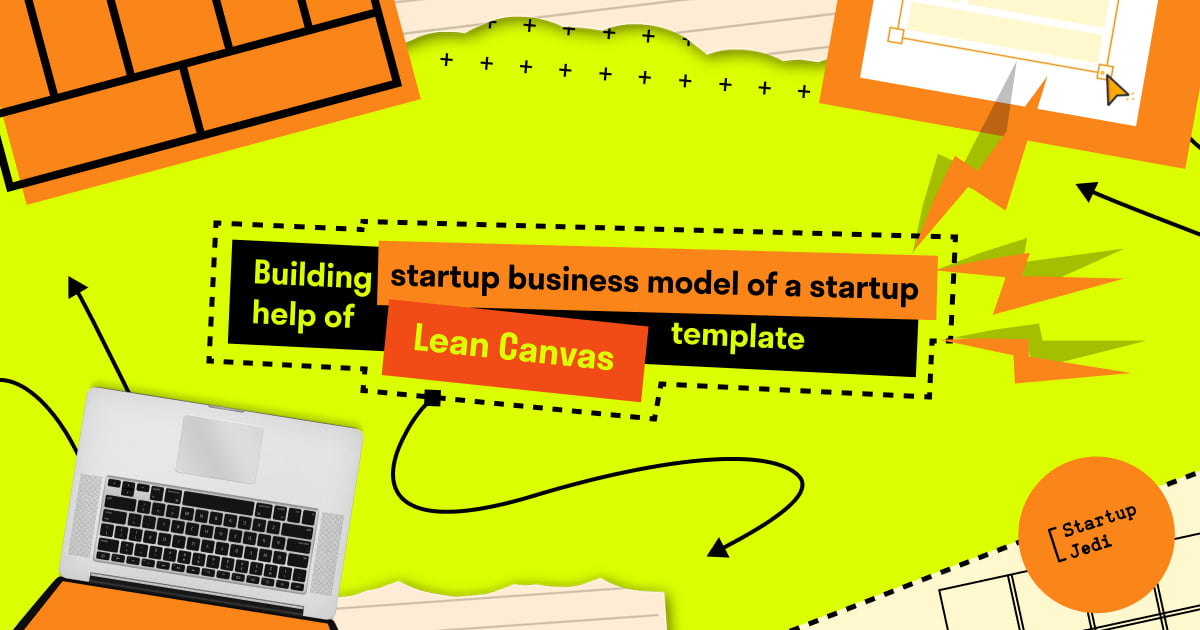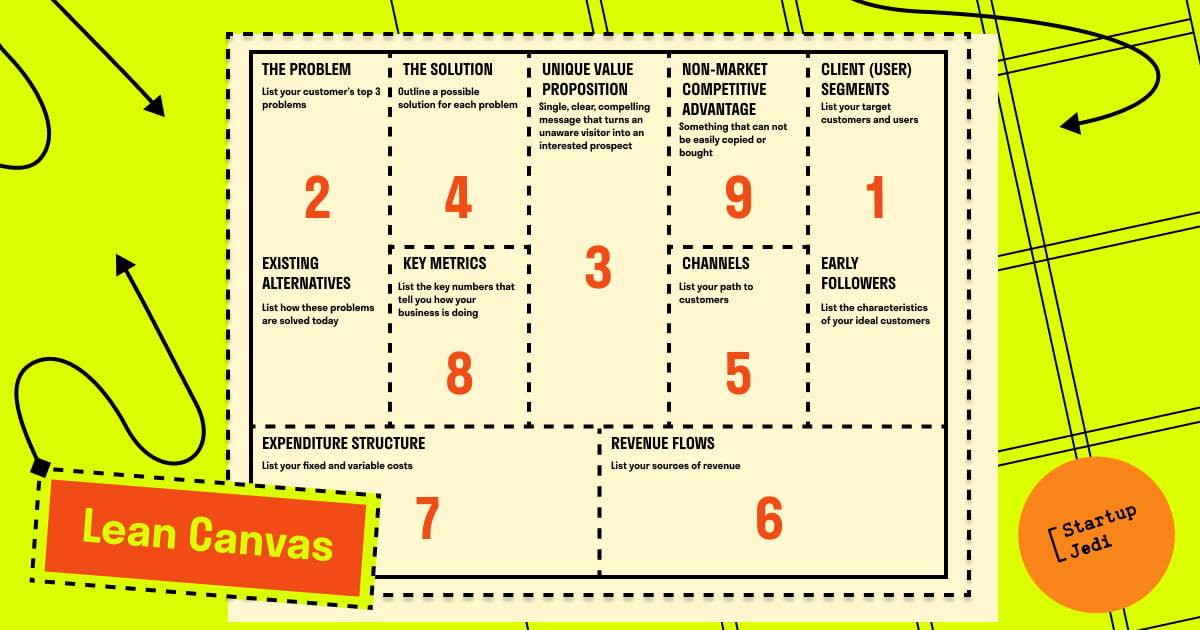
Startup Jedi
We talk to startups and investors, you get the value.
Lean Canvas is a strategic tool for describing and testing business models of a startup, company, project or product. It has appeared as an adaptation and a simplification of Alexander Osterald’s model. The base of the model became the term “lean startup”, about which we have recently told in the article “How to apply Lean Startup method to your project”. And now, we are going to talk about what the Lean Canvas tool is, why it is useful and how to use it properly.

Startup Jedi
We talk to startups and investors, you get the value.
In the first place, it is necessary for yourself. It wasn’t once that I had to listen to founders’ pitches and I saw the burning eyes, a lot of enthusiasm, a lot of words but the essence is vague since the description of the projects wasn’t structured in the founder’s head. He wants to tell everything at once, thus, he jumps from thought to thought, but this flow doesn’t sell his idea in any way. Lean Canvas is built of 9 blocks which help to structure the idea.
2. Cutting off the odds and testing hypotheses
Many ideas and many features usually harm the product, rather than help it. Filling out the business model template allows you to discard unnecessary functions, which don’t solve the clients’ problems, as well as, it helps to make a list of hypotheses that you need to test. As almost every point in the business model is a hypothesis.
...

Lean Canvas is built of 9 blocks. Let’s figure out what the blocks are and how you should fill them in.

In simple words, who is your target audience. But it is important to pay attention to the division between clients and consumers. Of course, many projects have their clients as consumers. But there are exceptions.
For example, you decided to create a mobile app for children. A parent is a client here since he will pay your company. And a child is the consumer as he will use your product. If you have conducted a huge marketing company, attracted clients, who are ready to pay, but their children don’t want to play/use your mobile app, then it is a hell of a problem. You’ll lose the clients quite soon. Thus, you need to find balance here: you have to develop the product for both the client and the consumer. And this means that you have to separately fill in the business model for these two categories. Or, at least, write them down in different colours.
The next (favourite) problem while defining your target audience is “Everybody needs my product”. One of my colleagues was always answering this phrase: “Then nobody needs your product”. It may be rude, but it depicts the essence: if you create the product for everyone, then it will be hard to reach out to someone specifically. Even if your startup plans to conquer the world — start from the specific and understandable target audience
To make it more clear, let’s look at filling out a business model with an example. Let’s see how you can fill in the business model using an example. Since we started discussing a mobile app for children, let’s keep using it as an example. Let’s make an application that helps to eliminate deficiencies in the child’s speech, that is, a digital speech therapist.
So, how would you fill in this field for your app:
Option 1
All children have speech development problems, so everyone needs our service! It is a bad option, as we discussed above.
Option 2
Children who have speech problems. Parents, whose children face difficulties in speech development. So here we have separated the client and the user, but the audience is very abstract. What does difficulty mean? At what age?
Option 3
The user: kids 2–3 years old, whose parents observe slight difficulties with the pronunciation of the letters “p, b, f, d, k, n, m and v” or “s, z, c, sh, zh, ch, shch”. The client: An active parent who monitors the development of their child. He sees that the kid has difficulties with certain letters and would like to help him. Thus, we distinguish the client and the user, clarify their behaviour and problems. We determine that we don’t solve difficult cases, because for this it is better to visit a speech therapist, and not use an application.

These are the clients who will be the first to use your application. For instance, there is a super professional speech therapist, who has private practices. He consults more than a hundred babies a month and 60% of them don’t need to visit the speech doctor, but it’s enough to train with parents or an app. The doctor will show your service to parents and teach them how to use it.

Sometimes when we create a product, we want to include as many features as possible, so it will be awesome. But while developing functions, you have to ask yourself questions: what problems do we solve, how do we make consumer’s and client’s lives better?
Let’s get back to our case. It is clear that 2–3-year-old babies don’t really care how they pronounce the letters. And here you solve the parent’s problem: so that my baby speaks beautifully, and he doesn’t have problems in the future due to speech.
You also solve the problem of lack of time and inconvenient logistics. Working out in the app at home or going to the doctor for a lesson — which is more convenient? Or maybe the application will take some load off the parent and the child will be able to do some exercises himself? Or maybe the child gets used to strangers for a long time, or is he afraid of doctors? Many children don’t agree to communicate with doctors at all until they are 10 years old.
So, you solve client problems:
Worrying about the child’s future and their normal development.
Little free time
It is hard to properly train speech problems with the child on your own since the parent is not a speech therapist.
Also, you solve the user problems:
The scare of doctors or new people.
Uninteresting and boring lessons, as there is a brave new world to discover!

Here you have to understand how people are living without your application. What do they do instead?
For example:
They go to the speech therapist.
They practice themselves with books and advisories.
They attend online meetings with doctors.
Watch videos on YouTube.
They don’t do anything and just hope that it will be solved by itself.

In this cell, you have to make a short and simple offer, which will show why you are better than competitors and the existing alternatives.
For example, you can focus on a unique methodology that, after a test lesson, creates an individual learning path for the baby specifically for their characteristics. Or you can focus on a bright, playful design that will captivate the child from the very first minute.

At last, we got to the solution! So what do we do in the end? How do we solve the clients’ problems?
A very comfortable method for a correct and clear answer is the elevator pitch. Imagine that you walk into the lift with a potential investor. He can’t run away from you. You have 30 seconds to tell about your project in a way that the investor would want to meet you and talk again. At first, write on paper or in Word all your thoughts about your product, using the previous 3 blocks. Reread. Rewrite and make it shorter. Do this until your entire speech fits in 30 seconds or less. Well, and a control check: read all this to grandmother. Did she understand everything? Then you did it!
Let’s get back to our example. Our app will help to analyse the child’s speech problems. Specifically for the age and characteristics of your child, the app will select the individual path of the classes. And it will plunge the child into a bright and fascinating world of sounds, so nobody could distract them away from the lessons.

How do your clients or users find out about the product? What advertising channels will you use? To answer these questions, you need to go back to your target audience. By analysing their behaviour and habits, you will understand which channels are best for you.
For your app, those might be:
Speech therapists, who consult parents
Parent forums, resources, mass media.
Neighbours, whose child is using the app.
Shows for children that parents watch with their babies. For example, the children’s song Baby Shark on YouTube has already gained almost 9B views! What if the heroes of the song will use your application?

How will your project make money? What monetization model will you use? Let’s say, your app will have a monthly subscription and paid consultations. In this block, you don’t need to count the financial model or define the subscription price. You have to advance the hypothesis which you will test.

What will you have to invest in while creating a product? What will be your monthly expenses? It’s better to answer without figures, just general categories.
For instance, developing and designing the app, developing lessons, marketing, office rental, technical payments (paying marketplaces to place your app, etc.), payments to consultants.

How would you define that you’re forwarding to success? What metrics will you check in the first place?
For instance, you decide that you will spend a lot of time and money on developing and perfecting the product, also, you will invest in marketing, so you will quickly find your market. Thus, you understand that with such expenses, there will be no fast income, so you define your key metrics:
The number of app downloads.
The number of subscriptions.
The time spent in the app.
The number of users, which continue to use the app after 30 days from registration.

What is your jam, which will be hard to steal? Maybe, it is a large client base or a famous brand?
But you’re still newbies, and do you remember our made-up super speech therapist? Let him be the author of a unique method, which helps children to eliminate speech problems. It is he who will create the lessons’ guidelines in the app. Together with a child psychologist and a methodologist, who will help to make these lessons interesting.
...
That’s all 9 blocks. They are simple but really help in structuring hypotheses. Now it’s time to test, refine and implement the project. And it’s important to remember that a business model is an everyday tool. You don’t develop a business model once and for the whole life of the business. No, you are constantly refining and adapting it to the realities of the time and the market.
Facebook: facebook.com/StartupJedi/
Telegram: t.me/Startup_Jedi
Twitter: twitter.com/startup_jedi
Comments